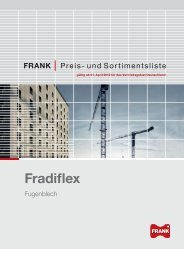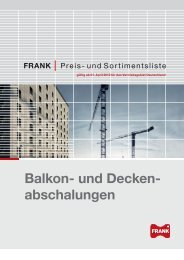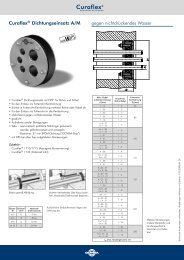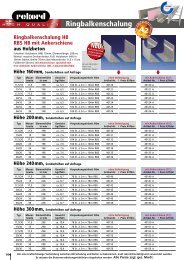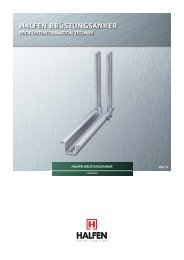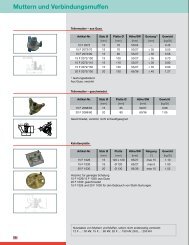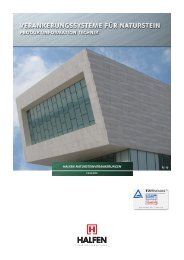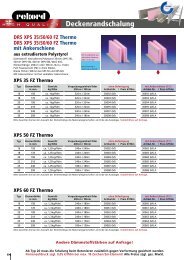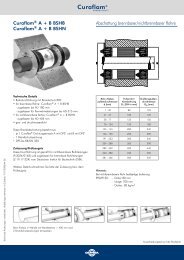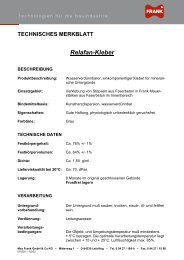Materialeigenschaften.pdf - bei FRINGS Bautechnik!
Materialeigenschaften.pdf - bei FRINGS Bautechnik!
Materialeigenschaften.pdf - bei FRINGS Bautechnik!
Sie wollen auch ein ePaper? Erhöhen Sie die Reichweite Ihrer Titel.
YUMPU macht aus Druck-PDFs automatisch weboptimierte ePaper, die Google liebt.
BESAPLAST ®<br />
Übersicht<br />
Besaflex ® : - Weich-PVC mit AbP 1) ,<br />
- Beanspruchung: Gering bis normal.<br />
Nitriflex ® : - PVC/ NBR nach DIN 18541,<br />
- Beanspruchung: Hoch,<br />
- Gute chemische Beständigkeit.<br />
Elastoflex ® : - Elastomer nach DIN 7865,<br />
- Beanspruchung: Hoch,<br />
- Hohe Elastizität.<br />
Besaflex ® BS: - Weich-PVC nach Werksnorm,<br />
- nach britischem Standard (BS).<br />
Polyflex: - Polyethylen nach Werksnorm,<br />
- Bevorzugt in Verbindung mit<br />
Flächenabdichtungen (PE-Folien).<br />
TPE: - Thermoplastisches Elastomer,<br />
- änlich Elastoflex, jedoch<br />
schweißbar.<br />
1) AbP = Allgemeines bauaufsichtliches<br />
Prüfzeugnis<br />
Besaflex ® nach Werksnorm<br />
Besalfex ® -Fugenbänder aus Weich-PVC bestechen<br />
durch ihre Vielzahl an guten Eigenschaften und durch<br />
hohe Wirtschaftlichkeit.<br />
Der Werkstoff Weich-PVC ist seit Anfang des 20en<br />
Jahrhunderts im Einsatz und wird ständig überprüft.<br />
Bevor dieses Material für Fugenbänder eingesetzt<br />
wurde, waren all seine positiven Eigenschaften,<br />
besonders seine Alterungsbeständigkeit, wissenschaftlich<br />
bewiesen.<br />
Besalfex ® -Fugenbänder eignen sich für alle normalen<br />
Beanspruchungen und decken somit den größten Teil<br />
der normalen Beanspruchungen <strong>bei</strong> Bauwerken ab.<br />
Sie sind säure- und laugenfest sowie verrottungsbeständig.<br />
Sie sind beständig gegen alle natürlich vorkommenden<br />
Agenzien.<br />
Nitriflex ® nach DIN 18541<br />
Das Material für unsere Nitriflex ® -Fugenbänder wurde<br />
so entwickelt, dass es den Anforderungen der DIN<br />
18541 entspricht. Es besteht aus qualitativ hochwertigen<br />
Grundstoffen und besitzt dadurch sehr große<br />
Reserven, die die Anforderungen der DIN teilweise<br />
übertreffen.<br />
Nitriflex ® -Fugenbänder nach DIN 18541 besitzen<br />
höchste Bruchdehnung, hervorragende<br />
Chemikalienverträglichkeit und Alterungsbeständigkeit<br />
sowie kautschukähnliche Dauerelastizität.<br />
Auch Nitriflex ® -Fugenbänder nach DIN 18541 gibt es<br />
in allen wichtigen Profilformen und eignen sich daher<br />
für Konstruktionen aller Art und höchsten<br />
Anforderungen.<br />
<strong>Materialeigenschaften</strong> /<br />
Material properties<br />
Digest<br />
Besaflex ® : - Soft-PVC with AbP 1) ,<br />
- Strain: low to normal.<br />
Nitriflex ® : - PVC/ NBR to DIN 18541,<br />
- Strain: high,<br />
- high chemical resistance.<br />
Elastoflex ® : - Elastomer to DIN 7865,<br />
- Strain: high,<br />
- high elasticity.<br />
Besaflex ® BS: - Soft-PVC to company standard,<br />
- complies with british requirements<br />
(BS).<br />
Polyflex: - Polyethylen to company standard,<br />
- prefered for connecting with plastic<br />
sealing sheets made from PE.<br />
TPE: - Thermoplastic elastomer,<br />
- similar to Elastoflex, but weldable.<br />
1) AbP = general building inspectorate test<br />
certificate<br />
Besaflex ® according to company standard<br />
Besaflex ® -waterstop made of plasticized PVC are<br />
distinguished by numerous of good characteristics and<br />
high economic efficiency.<br />
Plasticized PVC has been in use since the 20th century<br />
and is subject to constant monitoring. This material<br />
was not used for waterstops until all its positive characteristics,<br />
especially its resistance to ageing, had<br />
been scientifically verified.<br />
Meeting all normal requirements, Besaflex ® -waterstops<br />
are up to most structurally imposed strains.<br />
They are resistant to acid and alkaline solutions and<br />
decay as well as to all naturally occuring agents.<br />
Nitriflex ® according to DIN 18541<br />
The material for our Nitriflex ® waterstops to DIN<br />
18541 is manufactured from high-grade base materials<br />
and thus has very high reserves which go in part<br />
beyond the requirements of the DIN standard.<br />
Nitriflex ® waterstops to DIN 18541 specifications are<br />
characterized by maximum breaking elongation, outstanding<br />
resistance to chemicals and ageing, and permanent<br />
elasticity akin to that of rubber.<br />
Nitriflex ® waterstops to DIN 18541 specifications are<br />
available in all major profile shapes and are thus suitable<br />
for structures of all kinds with the most stringent requirements.<br />
Änderungen vorbehalten / subject to change 19<br />
3
3<br />
20<br />
<strong>Materialeigenschaften</strong> /<br />
Material properties<br />
Elastoflex ® nach DIN 7865<br />
Elastoflex ® -Fugenbänder sind aus Elastomern hergestellt.<br />
Elastomere sind weitmaschig vernetzte<br />
Hochpolymere (Kunstkautschuk), die vulkanisiert wurden.<br />
Auf Grund dieser nicht rückgängig machbaren<br />
Vernetzung ergibt sich eine besondere Art der<br />
Fügetechnik.<br />
Elastoflex ® -Fugenbänder sind besonders für Bauwerke<br />
mit größten Fugenbewegungen, häufigen Lastspielen<br />
und niedrigen Temperaturen geeignet.<br />
Unsere Elastoflex ® -Fugenbänder entsprechen der DIN<br />
7865.<br />
Polyflex nach Werksnorm<br />
Polyflex-Fugenbänder werden aus Polyethylen (PE)<br />
hergestellt und sind speziell für die Abdichtung von<br />
Fugen im Betonbau in Kombination mit<br />
Flächenabdichtungen wie z. B. Folien entwickelt worden.<br />
Polyflex-Fugenbänder aus modifiziertem PE bieten den<br />
Vorteil der guten Verschweißbarkeit, Verträglichkeit<br />
gegenüber aggressiven chemischen Medien, hohe<br />
Langzeitbeständigkeit und Mirkobenbeständigkeit.<br />
Auch <strong>bei</strong> niedrigen Temperaturen bleibt die<br />
Dauerelastizität und das Dehnungsvermögen erhalten.<br />
TPE nach Werksnorm<br />
Fugenbänder aus thermoplastischem Elastomer finden<br />
ihren Einsatzzweck insbesondere <strong>bei</strong> hohen<br />
Anforderungen an die Reißdehnung,<br />
Tiefentemperaturflexibilität, Alterungsbeständigkeit<br />
sowie UV-Beständigkeit.<br />
Ein weiterer Vorteil dieses Materials liegt darin, dass<br />
sich alle Verbindugen durch die thermoplastische<br />
Fügetechnik herstellen lassen.<br />
Änderungen vorbehalten / subject to change<br />
BESAPLAST ®<br />
Elastoflex ® according to DIN 7865<br />
Elastoflex ® waterstops are made of elastomer.<br />
Elastomers are high-polymers cross-linked with coarse<br />
meshing (synthetic rubber), which have been vulcanized.<br />
Because of this non-reversible cross-linking, a special<br />
type of jointing technique is required.<br />
Elastoflex ® waterstops are ideal for use in structures<br />
subject to major joint movements, frequently changing<br />
loads and low temperatures.<br />
Our Elastoflex ® waterstops are manufactured to the<br />
DIN 7865 specifications.<br />
Polyflex according to company standard<br />
Polyflex-waterstops have been purpose-development<br />
for<br />
structural sealing tasks. The waterstops have no connection<br />
strips, can be used for sealing joints in concrete<br />
irrespective of the plastic sealing sheeting.<br />
Polyflex-waterstops made of modified PE offer the<br />
advantage of good weldability, resistance to aggressive<br />
chemical media, high durability and resistance to<br />
microbes.<br />
The permanent elasticity and expansion characteristics<br />
are unaffected by low temperatures.<br />
TPE according to company standard<br />
Waterstops made from thermoplastic elastomers characterized<br />
are by maximum elongation<br />
at tear, low temperature flexibility, resistance to<br />
aging and high UV resistant.<br />
Joints of all kinds are produced fast and economically<br />
with the thermoplastic jointing, using standart equipment.
BESAPLAST ®<br />
Technische Daten /<br />
Technical facts<br />
Thermoplaste /<br />
Thermoplastics<br />
Shore-Härte A /<br />
shore hardness A<br />
Zugfestigkeit /<br />
tensile strength<br />
Bruchdehnung /<br />
elongation at break<br />
Herstellung nach /<br />
manufacturing according to<br />
Verfügbare Qualitäten /<br />
available qualities<br />
Besaflex ®<br />
<strong>Materialeigenschaften</strong> /<br />
Material properties<br />
Nitriflex ®<br />
75±5 67±5 DIN 53505<br />
Prüfmethode /<br />
test methode<br />
≥ 8 N/mm² ≥ 10 N/mm² DIN EN ISO 527-2<br />
≥ 275 % ≥ 350 % DIN EN ISO 524-2<br />
Werksnorm mit AbP 1) /<br />
company standard with AbP 1)<br />
DIN 18541<br />
NB 2) , PH 2) NB 2) , BV 2)<br />
Beide Materialien sind frei von Blei, Cadmium und Formaldehyd. /<br />
Both materials do not contain lead, cadmium and formaldehyde.<br />
1) AbP Allgemeines bauaufsichtliches Prüfzeugnis / general building inspectorate test certificate<br />
2) NB Nicht bitumenverträglich / not compatible with bitumen<br />
BV Bitumenverträglich / compatible with bitumen<br />
PH Physiologisch unbedenklich / physiologically harmless<br />
Elastomere /<br />
Elastomer<br />
Shore-Härte A /<br />
shore hardness A<br />
Reißfestigkeit /<br />
resistance to tearing<br />
Reißdehnung /<br />
elongation at tear<br />
Druckverformungsrest /<br />
compression set<br />
Herstellung nach /<br />
manufacturing according to<br />
Sonderqualitäten /<br />
special qualities<br />
Shore-Härte A /<br />
shore hardness A<br />
Zugfestigkeit /<br />
tensile strength<br />
Bruchdehnung /<br />
elongation at break<br />
Herstellung nach /<br />
manufacturing according to<br />
Elastoflex ®<br />
62±5 62±5 DIN 53505<br />
≥ 10 N/mm² ≥ 10 N/mm² DIN 53504<br />
≥ 380 % ≥ 600 % DIN 53504<br />
≤ 20 % ≤ 35 % DIN ISO 815<br />
DIN 7865<br />
80±5<br />
Besaflex ® BS<br />
TPE<br />
Werksnorm /<br />
company standard<br />
Prüfmethode /<br />
test methode<br />
BS 2782: Part 3<br />
methode 365B<br />
Polyflex<br />
Prüfmethode /<br />
test methode<br />
Prüfmethode /<br />
test methode<br />
≥ 90 DIN 53505<br />
≥ 13 N/mm² ASTM D638M-93 ≥ 17 N/mm² DIN EN ISO 527-2<br />
≥ 285 % ASTM D638M-93 ≥ 700 % DIN EN ISO 527-2<br />
Werksnorm /<br />
company standard<br />
Beide Materialien sind frei von Blei, Cadmium und Formaldehyd. /<br />
Both materials do not contain lead, cadmium and formaldehyde.<br />
Werksnorm /<br />
company standard<br />
Änderungen vorbehalten / subject to change 21<br />
3
3<br />
22<br />
<strong>Materialeigenschaften</strong> /<br />
Material properties<br />
Materialien für den Einsatz im Trinkwasserbereich<br />
Besaplast ® -Fugenbänder werden auch für den Einsatz<br />
mit Trinkwasserkontakt hergestellt. Diese werden aus<br />
einem weichen, färbbarem und flexiblen thermoplastischen<br />
Elastomer hergestellt sowie aus Polyethylen.<br />
Diese kombinieren guten Eigenschaften und<br />
Verar<strong>bei</strong>tbarkeit, zusätzlich in Übereinstimmung mit<br />
nationalen und europäischen Vorschriften für<br />
Kunststoffe mit Trinkwasserkontakt. Die Materialien<br />
sind vollständig recyclebar.<br />
Besondere Merkmale:<br />
- nicht hygroskopisch,<br />
- excellente, mechanische Eigenschaften <strong>bei</strong><br />
Raumtemperatur,<br />
- gute Beibehlatung der Eigenschaften nach der<br />
Langzeitalterung im Wasser,<br />
- naturfarben,<br />
- in Übereinstimmung mit der EU Richtlinie<br />
2003/11/EC.<br />
<strong>Materialeigenschaften</strong>/<br />
material properties<br />
Shore-Härte A /<br />
shore hardness A<br />
Zugfestigkeit /<br />
tensile strength<br />
Bruchdehnung /<br />
elongation at break<br />
TPE<br />
Änderungen vorbehalten / subject to change<br />
BESAPLAST ®<br />
Materials for drinking water contact applications<br />
Besaplast ® -Waterstops are also designed and targeted<br />
for drinking water contact applications. These are<br />
extruded from a soft, colourable, flexible thermoplastic<br />
elastomere or from polyethylen.<br />
It combines good properties and processability, in<br />
addition to compliance with national and european<br />
regulations. The materials are completely recyclable.<br />
Key features:<br />
- non-hygroscopic material,<br />
- excellent mechanical properties at room temperature,<br />
- good properties retention after long term aging in<br />
water<br />
- natural colour,<br />
- compliant to EU Directive 2003/11/EC.<br />
Prüfmethode /<br />
test methode<br />
62±5 ISO 868 ≥ 90<br />
≥ 12 N/mm²<br />
≥ 800 %<br />
ISO 37/<br />
ASTM D 412<br />
ISO 37/<br />
ASTM D 412<br />
PE<br />
≥ 20 N/mm²<br />
≥ 700 %<br />
Prüfmethode /<br />
test methode<br />
ISO 868/<br />
ASTM D 882<br />
ISO 527/<br />
ASTM D 882<br />
ISO 527/<br />
ASTM D 882




